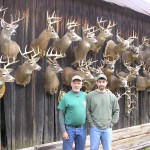This coming season I’ll celebrate 33 years of hunting on public land. While I’ve hunted a few parcels of private land over the years the vast majority of my hunting has been done on public land open to everyone including photographers, walkers, bikers, naturalists, hunters and anyone else who wants to use the land. I’m going to share the knowledge I’ve acquired to help any on you who plan on getting more in depth with your adventures on public land.
When you’re dealing with that many types of people it can sometimes become very frustrating. You might search for hours or even days to find a good place to set your stand. All of your hard work can culminate with someone walking under your stand shortly before darkness. The person will whistle a few times at their dog and angrily begin scolding it if it decides to ignore his/her commands. This could go on for a few minutes or carry on for an extended period of time. Either way it makes you question everything you’ve done.
Depending on where you’re hunting this could be a regular occurrence or something you could never imagine. I’ve experienced both, so it’s a good idea to be prepared for any situation you might encounter. Throughout the Midwest a lot of public ground borders the properties of a number of different landowners, however, in the Northeast you could walk for two full days before seeing any sign of another human being.
With these things in mind you have to be realistic with your expectations when you choose where you’re going to hunt. If you’re hunting around a lot of private ground expect to be interrupted by a variety of activities. You might see kids playing along the fence line on the ridge above you. You might see someone cutting firewood. You might have a motorcycle or four wheeler rip past you right around the peak times. If it can happen it will. There’s no doubt about it.
When you encounter these things you have to remember that the deer are probably comfortable with all of the disturbances. If a deer inhabits an area it becomes conditioned to the surrounding environment. Many hunters think the pressure on public land makes deer a lot harder to kill. In some ways this is probably true, but in others you have to understand the deer are much more at ease with human interference because they experience it at much greater rates than deer on secluded tracts of private land.
Deer might act tense and on edge on public land. They will appear alert at all times. Any hint of movement will send them to the next county. They will wander around with their eyes looking up into the trees. If you jump one it will take off and never stop running.
If you run into situations like the ones described above it’s probably a good idea to search for a different piece of land to hunt. Try to find a place where deer aren’t skittish. Skittish deer are the hardest ones to kill. If immature deer are on edge the mature ones will be even worse. When a mature deer becomes nervous it will find a new place to hide. No matter how hard you try to find them it seems almost impossible to figure out where they have gone. Occasionally you’ll stumble across a couple, but more times than not you’ll head out of the woods with your tail dragging between your legs.
Always try to observe the behavior of deer in the areas you’re hunting. The behavior will tell you a lot about what you need to know, especially if the place is hunted hard. If you’ve never been there before you’re just guessing about the amount of pressure the land receives. The guesses can be misleading if you don’t see any trucks parked on the side of the road. It could just be the day you’ve arrived. The day before there could have been five or six vehicles in one parking area as well as others lined up on the shoulder of the road. But, the behavior of the local deer herd won’t mislead you. Pay attention to that detail and you won’t be led astray. Although I’ve killed some good bucks on highly pressured pieces of public ground I’ve had much better luck in less pressured areas. Next time I’ll try to hit on how to make an educated guess as to whether or not a piece of land you’re studying endures a lot of human activity.
